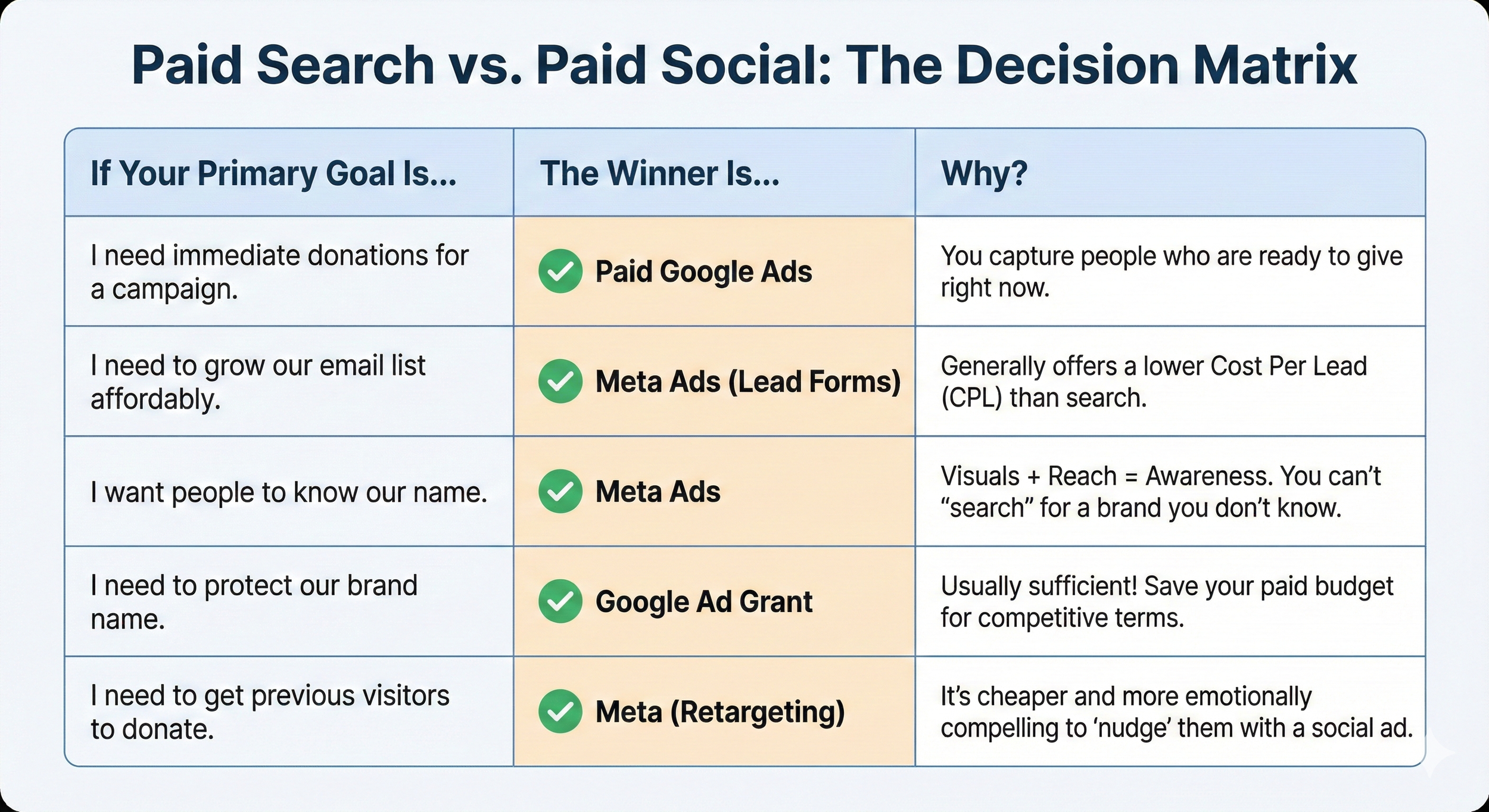Paid Search vs. Paid Social: Where Should Your Nonprofit Invest?
You have a marketing budget. It might be $500 or $50,000, but the pressure is the same: Don’t waste it.
As a nonprofit marketer, you are likely juggling multiple platforms, aiming to squeeze every ounce of impact from every dollar. One of the most common questions we’re asked is, "Which is better: Google Ads or Facebook Ads?"
To answer this, we first need to make a critical distinction. We aren't talking about your Google Ad Grant today. The Ad Grant is an incredible "free" resource, but it has limitations. Today, we are talking about Paid Search (spending real dollars to secure top placement) vs. Paid Social (investing in Meta/Facebook & Instagram to stop the scroll).
This isn't a cage match where one platform wins and the other loses. It’s a question of Intent vs. Discovery. Google captures people looking for answers; Meta finds people who care about problems.
Knowing the difference is how you budget smart.
Paid Google Ads: Capturing Intent (The "Pull" Strategy)
Core Function: Capturing demand that already exists.
When someone types "donate to emergency relief" into Google, they have their wallet out. They are intent on taking action. Paid Google Ads allow you to "pull" that high-value user directly to your donation page.
"But I have the Ad Grant. Why should I pay?" Fair question. The Ad Grant is powerful, but Paid Search unlocks capabilities the Grant simply cannot match:
Beat the Competition: Paid ads always appear above Ad Grant ads. For competitive keywords, the Ad Grant often isn't enough to win the click. If you absolutely must be #1, you need a paid budget.
Unlock New Formats: Paid accounts give you access to Display Ads (banners on other sites), YouTube Ads, and Performance Max—visual formats that the text-only Ad Grant does not support (PMax campaigns in the Ad Grant are currently Search and Google Maps placements).
True Retargeting: You can use paid ads to "follow" visitors who left your donation page without giving, reminding them to complete their gift.
Best Use Cases for Paid Search:
Direct Fundraising: Capturing high-intent searches like "donate to [cause]" or "best charity for [issue]."
Emergency Response: When news breaks, search volume spikes. Paid ads get you to the top immediately, faster than SEO or Grant optimization.
High-Value Leads: Targeting corporate partnerships or major gift keywords that are too competitive for the Grant.
The Drawback: It can be expensive. You are paying a premium for that high intent. A single click for a competitive keyword can cost $2–$5 or more.
Meta Ads (Facebook & Instagram): Generating Demand (The "Push" Strategy)
Core Function: Interrupting the feed to create interest where there wasn't any 5 seconds ago.
You can’t "search" for a feeling. That is where Meta shines. It allows you to "push" your mission into a user's feed, using video and imagery to make them feel the urgency of your work.
Core Strength: Visual Storytelling & Audience Targeting Unlike Google, which targets keywords, Meta targets people. You can find users based on their interests (e.g., "Animal Welfare"), demographics (e.g., "Parents of toddlers"), or behaviors.
Lookalike Audiences: This is Meta's superpower. You can upload your email list of donors, and Meta will find thousands of new people who "look" and act just like them.
Best Use Cases for Paid Social:
Brand Awareness: Introducing your mission to a cold audience who has never heard of you.
Lead Generation: Using Lead Forms to capture email sign-ups directly in the app, without the user ever leaving Facebook or Instagram.
Visual Impact: Showing the "before and after" of your work (e.g., a restored forest, a rescued animal).
Retargeting: Showing a heartfelt video to someone who visited your website last week but didn't donate.
The Drawback: Creative fatigue. On Google, a text ad can run for months. On social, people get bored of seeing the same image quickly. You need to budget for creating the ads (images/video), not just placing them.
The Money Talk: How to Budget for Each
How much should you spend? The answer isn't a random number; it's math.
1. Budgeting for Google (The CPC Model)
The Formula: Target Keyword Volume x Estimated CPC.
How to calculate: Use Google’s Keyword Planner. If you want to target "food bank donation," and the click costs $3.50, and you want 100 visitors a month, you need a $350/month budget for that campaign.
Tip: You often need a minimum of $500–$1,000/month to give Google’s AI enough data to optimize properly.
2. Budgeting for Meta (The CPM Model)
The Formula: Audience Size x Frequency x Creative Costs.
How to calculate: On Meta, you typically pay for impressions (CPM). You can start smaller here—boosting top-performing posts for $100–$500/month is a valid strategy.
Hidden Cost Warning: You must budget for creative production. If you spend $1,000 on ads but use a blurry photo, you wasted $1,000.
This table provides a quick overview to help you choose the right paid advertising platform for your nonprofit's specific goals. Remember to always test and analyze your results to optimize your campaigns!
The Full-Funnel Approach
The most successful nonprofits don't strictly choose one over the other; they allocate resources to make them work together.
A sophisticated integrated campaign might use Meta Ads to tell a story and build a retargeting pool (getting people to visit your site), and then use Paid Google Ads (or your Ad Grant) to capture those same people when they search for you later to make a gift.
Take out the guess work.
Confused by the math? Unsure if your creative is strong enough for social? Good Dog Strategies is here to help you build a budget that actually delivers a return on your mission.






